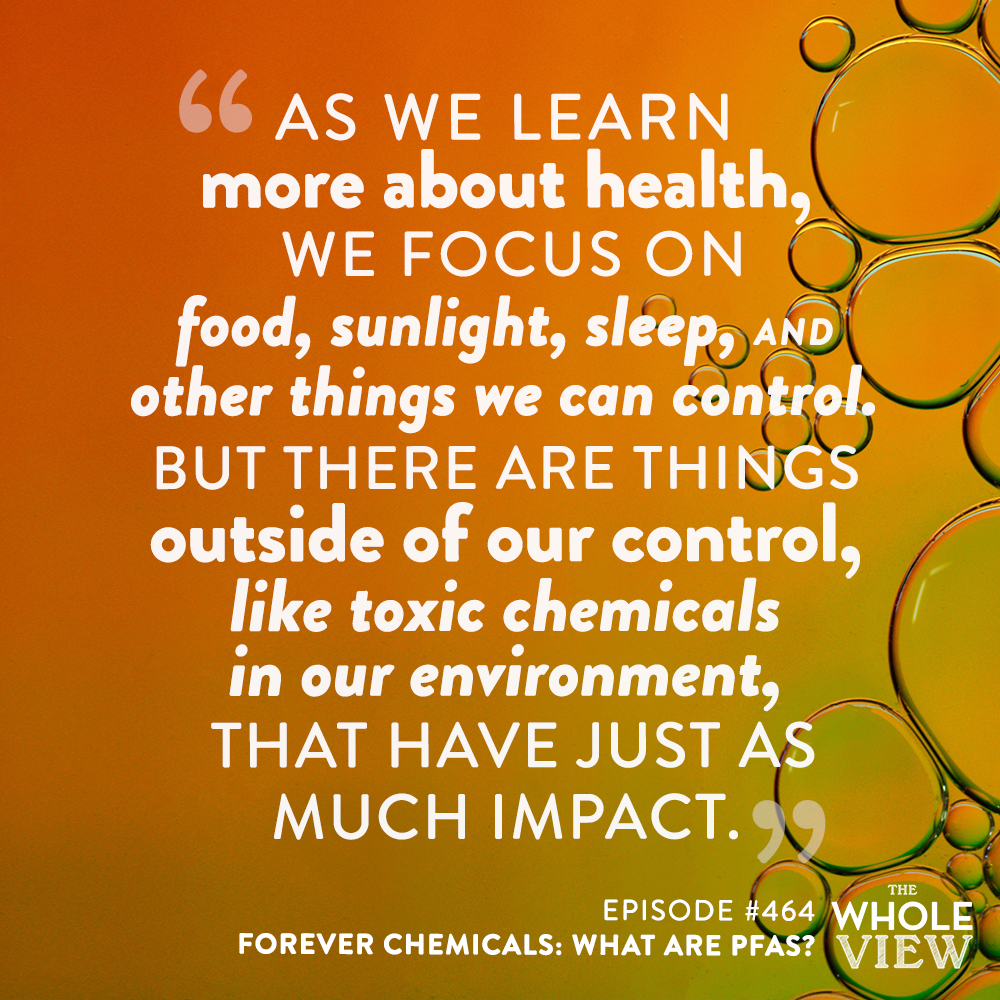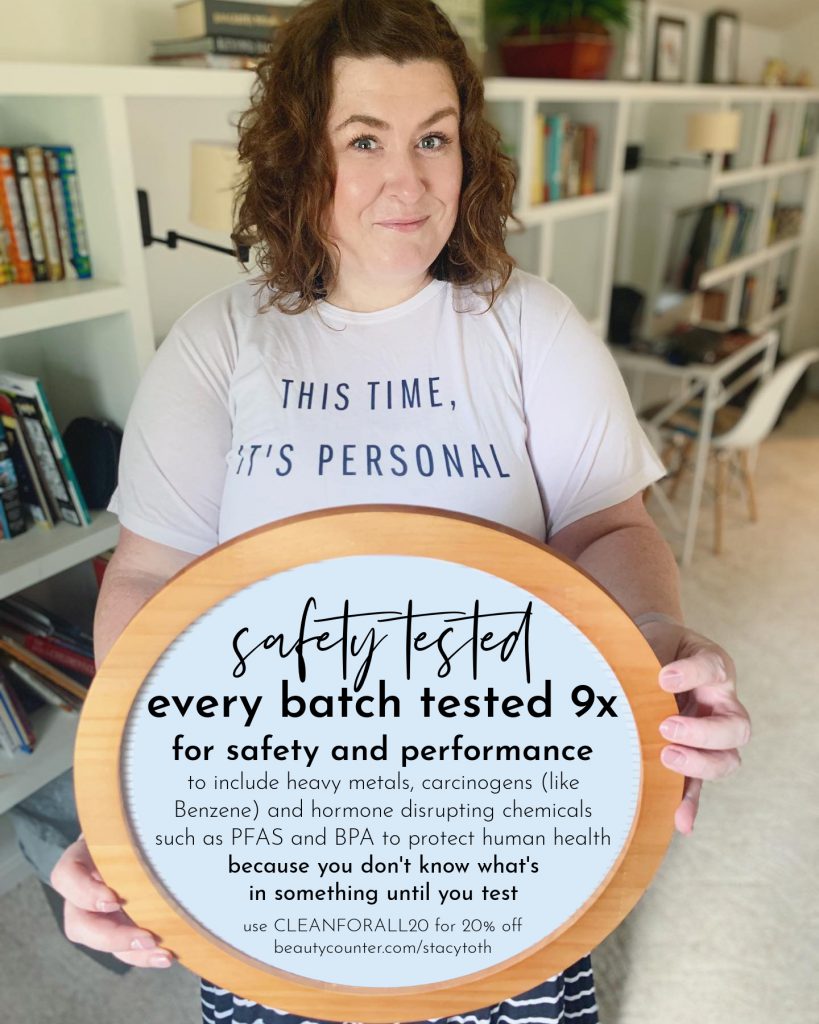
Welcome to episode 464 of The Whole View! This week, Sarah and Stacy dive into the science of PFAS and forever chemicals, why they are so problematic, and what we can do to limit our exposure and make a change.
If you enjoy the show, please review it on iTunes!
The Whole View, Episode 464: Forever Chemicals: What are PFAS?
Welcome back to episode 464! (0:28)
Science has shown, pretty unequivocally, how harmful these chemicals are for decades. It’s not recent science. And what we see in modern days is regulatory agencies not being able to keep up with capitalism demands.
This topic is difficult to see in something other than a “conspiracy” lens. But that is why it’s important to Stacy and Sarah now, more than ever, to make sure they stick to scientific research as much as possible.
There are specific areas known to have high levels of PFAS. If you know you’re in one of those areas, it’s possible to test your blood for your exposure levels.
Stacy reminds the audience that she and Sarah are not medical professionals. So, if you have any health concerns around this topic, be sure to see a doctor.
What Are Forever Chemicals?
PFAS are a class of man-made chemicals used to make products greaseproof, waterproof, and stain-resistant. (7:30)
They are “forever chemicals” because they and their breakdown products are extremely persistent, lasting thousands of years or more. But, unfortunately, we have no way to speed up the breakdown, so they end up bioaccumulating in the environment and our bodies.
Of the more than 9,000 known PFAS compounds, the U.S. uses 600 alone!
Countless products, including firefighting foam, cookware, cosmetics, carpet treatments, and even dental floss, contain PFAS compounds.
PFAS stands for perfluoroalkyl and polyfluoroalkyl substances- chemicals with at least one aliphatic perfluorocarbon moiety (e.g., -CnF2n-).
PFAS includes multiple subclasses of chemicals:
- PFAA – perfluoroalkyl acids and perfluoroalkylether acids
- PFOS – perfluorooctanesulfonic acid
- PFOA – perfluorooctanoic acid (C8, used to make PTFE polytetrafluoroethylene, aka Teflon)
- PFAA precursors
- Fluoropolymers
- Perfluoropolyethers
- other (primarily less reactive) PFAS
The most consistent feature within the class of PFAS is that their perfluorocarbon moieties do not break down or do so very slowly under natural conditions. This is why PFAS have often termed “forever chemicals.”
Because PFAS are persistent, they accumulate or concentrate in the environment, including water, air, sediment, soil, and plants.
Elevated levels of PFAS and their widespread presence in environmental media and drinking water stem from industrial sites that produce or use PFAS, airports, military bases (fire-training and response areas), landfills, wastewater treatment plants, and the spreading of PFAS-contaminated biosolids.
Some PFAS are highly mobile in either air or water. This allows them to travel long distances from their sources.
It’s important to note that we don’t metabolize PFAS molecules.
Sarah recommends this great article and this review for more information.
How Do They Harm Health?
A better question might be how do they not harm health because their detriment is incredibly pervasive. (10:50)
Data from toxicokinetic studies of PFAA indicate that they are generally well-absorbed after ingestion.
After absorption, they distribute blood to organs and tissues that receive high blood flow, such as the liver, kidney, lung, heart, skin, testis, brain, bone, and spleen.
Because PFAA can occupy sites on multiple receptors, proteins, and cell interfaces in the body, they can produce physiological effects across various tissues.
Nine nuclear receptors are activated (controls gene expression), including PPAR-alpha, which controls fatty acid beta-oxidation and is a major regulator of energy homeostasis.
They also bind to a variety of serum proteins, including steroid hormones and albumins, which are transport proteins (e.g., vitamin D-binding protein)
Scientists have found direct links (with mechanisms identified) between PFAS exposure and kidney and testicular cancer, thyroid disease, liver damage, developmental toxicity, ulcerative colitis, high cholesterol, decreased fertility, pregnancy-induced preeclampsia and hypertension, and changes in hormone functioning.
Immune dysfunction, such as Asthma, Osteoarthritis, Crohn’s & U.C., R.A., Type 1 diabetes, Lupus, and M.S, are also linked to PFAS.
PFAA and the Immune System
Effects on the immune system are some of the most well-studied health effects of PFAA. (14:51)
Multiple lines of evidence support PFAA as immunotoxicants and, more specifically, immunosuppressants at small administered doses in rodents and measured serum concentrations in humans.
Findings of suppressed vaccine response in humans and T cell-dependent antibody response in experimental animals led the U.S. National Toxicology Program (NTP) to classify PFOA and PFOS as presumed immune hazards to humans.
In a recent draft toxicological profile, the U.S. Agency for Toxic Substances and Disease Registry (ATSDR) extended this finding to PFHxS and perfluorodecanoic acid (PFDeA), identifying all four compounds as suppressants of antibody response in humans.
They are also unregulated greenhouse gasses!
Sarah explains that these chemicals are in our environment, all around, which makes them impossible to avoid. Also, there is data showing they can, in fact, be absorbed through the skin, not just when ingested, as many company websites indicate.
Additional associations still need further study to identify mechanisms, but dose responses are very damning!
- Obesity & Diabetes: A Review of Epidemiologic Findings
- Association with risk of cardiovascular diseases
- Obesity (dose response)
- Type 2 diabetes
- Non-alcoholic fatty liver disease
- Cardiovascular disease
- Osteoporosis
- PFAS magnifies metabolic effects of poor diet
PFAS Buildup and Our Bodies
Even more worrisome, this study showed 100% of breastmilk tested contained PFAS.
An analysis of the available breast milk PFAS data from around the world showed that while the phased-out PFOS and PFOA levels have been declining, the detection frequencies of current-use short-chain PFAS have been increasing (with a doubling time of 4.1 years).
This is consistent with the idea that they are forever and build-up. So even with using less, we’re still seeing a build-up over time.
There is a ton of current legislation pending to limit and/or ban PFAS in cosmetics.
For listeners who might not know, Stacy is a huge advocate for clean beauty and safer skincare. She works with Beauty Counter to help get safer products into consumer’s hands and uses her background in government to lobby for safer beauty standards.
With all the safer skincare legislation Stacy has seen in recent years, she decided to research the history of PFAS to see if even more legislation is necessary. It turns out- it is.
Sarah has recently gotten into the “Dark History” YouTube series by Bailey Sarian. Episode 1 is on this very topic, “The DuPont Chemical Poisoning.”
The film “Dark Waters” (which Sarah just watched with a free Showtime trial) is a not-quite-as-cool Erin Brokovich approach to going into detail.
History: Discovery to Litigation
Stacy runs through a quick timeline: (25:52)
- 1930 General Motors and DuPont formed Kinetic Chemicals to produce Freon.
- 1935 Dupont opened “one of the first in-house toxicology facilities” on the advice of a DuPont in-house doctor named George Gehrmann. The facility was meant to thoroughly test all du Pont products as a public health measure to determine the effects of du Pont’s finished products on the “health of the ultimate consumer” and that the products “are safe” before going “on the market”.
- 6 April 1938 a 27yo research chemist worked at the DuPont’s Laboratory with gases related to DuPont’s Freonrefrigerants. When an experiment he was conducting produced an unexpected new product: polytetrafluorethylene (PTFE), a saturated fluorocarbon polymer—the “first compound in the family of Perfluorinated compounds (PFCs) marketed commercially.” It took ten years of research before polytetrafluorethylene (introduced under its trade name Teflon) became known for being “extremely heat-tolerant and stick-resistant.”
- 1950s 3M manufactures PFAS, according to the 2016 lawsuit brought against 3M, 3M had “disposed of PFCs, and PFC-containing waste at a facility is owned and operated in Oakdale, Minnesota (the “Oakdale Facilities”)” during the 1950s. It contaminated residential drinking water wells with volatile organic compounds (VOCs) and heavy metals. It later became a city park after extensive cleanup.
- 1951 “The DuPont chemical plant in Washington, West Virginia, began using PFOA in its manufacturing process.”
- 1954 DuPont received an inquiry about C8’s “possible toxicity.”
- 1956 A study at Stanford found that “PFAS binds to proteins in human blood.”
- 1960s DuPont knowingly buries hundreds of drums of C8 on the banks of the Ohio River
- 1963 The Navy began to work with 3M to develop aqueous film-forming foams (AFFF). 1961 A DuPont in-house toxicologist said C8 was toxic and should be “handled with extreme care.”
- 1965 DuPont sent an internal memo describing preliminary studies that showed that even low doses of a related surfactant could increase the size of rats’ livers, a classic response to exposure to a poison.
- 1970s 3M (appears to) discover PFAS accumulate in human blood. 3Ms own experiments on rats and monkeys concluded that PFAS compounds “should be regarded as toxic.”
- 1976 The Toxic Substances Control Act provides EPA with authority to require reporting, record-keeping and testing requirements, and restrictions relating to chemical substances and/or mixtures. Certain substances generally excluded from TSCA include food, drugs, cosmetics, and pesticides. This list did not disclose any PFAS contaminants.
- 1983 3M announced their $6 million hazardous waste cleanup from their disposal processes.
- 1998 “Dark Waters” lawyer, Robert Billott, took a case representing Wilbur Tennant, a W.V. farmer, whose had a herd of cattle decimated by strange symptoms.
- 1998 The EPA was first alerted to the risks of PFAS—human-made “forever chemicals” that “never break down once released and they build up in our bodies.” In a 2000 Times article, the EPA said that they first talked to 3M in 1998 after they were first alerted to 3M’s 1998 laboratory rat study in which “male and female rats [received] doses of the chemical and then mated. When a pregnant rat continued to get regular doses of about 3.2 milligrams per kilogram of body weight, most of the offspring died within four days.”
- Summer of 1999 Bilott filed suit.
- 2000 a study widely detected PFOS in wildlife throughout the world” and that “PFOS is widespread in the environment.” They said that “PFOS can bioaccumulate to higher trophic levels of the food chain” and that the “concentrations of PFOS in wildlife are less than those required to cause adverse effects in laboratory animals.”
- 17 May 2000 3M stopped manufacturing “PFOS (perfluorooctanesulphonate)-based flurosurfactants using the electrochemical flouorination process,” which is a “class of chemicals known as perfluorochemicals (PFCs). Stacy didn’t even get into how the Navy and other public services used them to fight fires and increase environmental fire with Aqueous Film Forming Foams (AFFF).
- 17 May 2000 3M stops manufacturing Scotchgard because of their “corporate responsibility” to be “environmentally friendly.” Their tests proved PFOS, an agent that 3M used in the fabrication of Scotchgard— which lingers in the environment and humans. Barboza said that 3M’s “decision to drop Scotchgard” would likely affect DuPont’s use of PFOAs in the manufacturing of Teflon. Their testing showed “it does not decompose, it’s inert—it’s persistent; it’s like a rock.”
- August 2000 Bilott discovers PFOA or C8 in DuPont’s dumping sites
- Fall of 2000 Bilott gets access to 110,000 pages of documents dated back to the 1950s of DuPont’s “private internal correspondence, medical and health reports and confidential studies conducted by DuPont scientists.”
- March 2001 DuPont settled the lawsuit filed by Billot on behalf of Tennant for an undisclosed sum. Bilott sends a 972-page submission to directors of all relevant regulatory authorities: EPA and US AG demanding “immediate action to regulate PFOA
- 31 August 2001 Bilott files a class-action suit on behalf of thirteen individuals in the “Leach case.”
- 23 November 2004 The class-action lawsuit settled and “established a court-approved scientific panel to determine what types of ailments likely linked to PFOA exposure.” This led to thousands of residents then opting to pursue individual lawsuits after medical monitoring showed harm.
- 2005-2006 The C8 Health Project undertaken by the C8 Science Panel “surveyed 69,030 individuals” who had “lived, worked, or attended school for ≥ 1 year in one of six contaminated water districts near the plant between 1950 and 3 December 2004.”
- 2006 The EPA brokered a voluntary agreement with DuPont and eight other major companies to phase out PFOS and PFOA in the United States.
- 2014 The EPA’s Federal Facilities Restoration and Reuse Office (FFRRO) developed and published a fact sheet which provided a “summary of the emerging contaminants perfluorooctane sulfonate (PFOS) and perfluorooctanoic acid (PFOA), including physical and chemical properties, environmental and health impacts, existing federal and state guidelines, detection and treatment methods.
- 2016 The EPA “published a voluntary health advisory for PFOA and PFOS,” which warned that “exposure to the chemicals at levels above 70 parts per trillion, total, could be dangerous.”
- 13 February 2017 The 2001 class-action suit that Bilott had filed against DuPont, on behalf of the Parkersburg area residents, resulted in DuPont agreeing to pay $671 million in cash to settle about 3,550 personal injury claims. These claims involved a leak of perfluorooctanoic acid—PFOA or C-8— used to make Teflon in its Parkersburg, West Virginia-based Washington Works facilities. DuPont denied any wrongdoing.
- Fall 2017 abnormally high levels of PFAS found in Belmont, Michigan, became one of the first places where PFAS contaminations caught the media’s attention.[71] Wolverine Worldwide, a footwear company, was said to be the cause due to their use of Scotchgard to “treat shoe leather” and had dumped their waste in that area decades ago.
- 2017 PFAS are on Canada’s 2019 chart of substances prohibited by the Canadian Environmental Protection Act, 1999 (CEPA) and by Prohibition of Certain Toxic Substances Regulations, 2012. These substances are under these regulations because they are “among the most harmful” and “declared toxic to the environment and/or human health,” are “generally persistent and bioaccumulative.” The “regulations prohibit the manufacture, use, sale, offer for sale or import of the toxic substances listed below, and products containing them, with a limited number of exemptions.” [72]
- 10 January 2018 According to the U.S. Department of Health & Human Services’s Agency for Toxic Substances and Disease Registry (ATSDR), studies in humans with PFAS exposure show certain PFAS may affect growth, learning, and behavior of infants and older children, lower a woman’s chance of getting pregnant, interfere with the body’s natural hormones, increase cholesterol levels, affect the immune system, and increase the risk of cancer.”
- 30 January 2018 three branches of the EPA exchanged chains of emails with OMB, DoD, HHS, and the Pentagon, to put pressure on the Agency for Toxic Substances and Disease Registry (ATSDR). It aimed to censor a report that measured the “health effects” of PFAS that are “found in drinking water and household products throughout the United States.” An email by an unidentified white house administration forwarded by OMB said that “The public, media, and Congressional reaction to these numbers is going to be huge. The impact to EPA and [the Defense Department] is going to be extremely painful. We (DoD and EPA) cannot seem to get ATSDR to realize the potential public relations nightmare this is going to be.”
- March 2018 The United States Department of Defense’s (DoD) ‘s report to Congress said the test they conducted showed the amount of PFAS chemicals in water supplies near 126 DoD facilities “exceeded the current safety guidelines.” [65] The DoD “used foam containing” PFAS chemicals “in exercises at bases across the country.” The DoD, therefore, “risks the biggest liabilities” concerning the use of PFAS chemicals, according to Politico (published May 2018)
- 21 June 2018 The Department of Health & Human Services Agency for Toxic Substances and Disease Registry(ATSDR) 697-page draft report for public comment, “Toxicological Profile for Perfluoroalkyls,” was finally released.
- June 2019 Described as a “huge step toward cleaning up the prevalence of and prevent further contamination from PFAS chemicals in-ground, surface and drinking water,” the Department of Environmental Services of the state of New Hampshire submitted a “final rulemaking proposal” for new, lower maximum contaminant levels. They then filed a lawsuit against Dupont, 3M, and other companies for their roles in the crisis in drinking water contamination in the United States. The lawsuit claims that the polluted water results from the manufacture and use of perfluorinated chemicals, a group of more than 9,000 compounds collectively known as PFAS.[2]
- September 2019, Andrew R. Wheeler, EPA Administrator, met with industry lobbyists and said that “Congressional efforts to clean up legacy PFAS pollution in the National Defense Authorization Act for fiscal 2020″ were “just not workable.” Wheeler refuses to “designate PFAS chemicals as “hazardous substances” under the Superfund law.”
- 1 October 2019 A lawsuit filed in the Merrimack County Superior Court by 3M and two others against the state aimed to prevent the new permitted levels for PFOA, PFOS, PFNA, and PFHxS from implementation.
- 4 October 2019 over 100 scientific experts representing many countries “recommended that a group of hazardous chemicals”—”Perfluorohexane sulfonic acid (PFHxS), its salts, and PFHxS-related compounds”—be eliminated to better protect human health and the environment from its harmful impacts.”
- 10 March 2020 EPA announced its proposed regulatory determinations for two PFAS in drinking water. In a Federal Register notice, the agency requested public comment on whether it should set maximum contaminant levels for PFOA and PFOS in public water systems.
- April 2021: Landmark bipartisan legislation proposed to protect all Americans and our environment from harmful forever chemicals known as per- and polyfluoroalkyl substances (PFAS). The package establishes a national drinking water standard for select PFAS chemicals, designates as hazardous to allow the Environmental Protection Agency (EPA) to clean up contaminated sites
- https://debbiedingell.house.gov/news/documentsingle.aspx?DocumentID=2975
- June 2021: No PFAS in Cosmetics Act introduced with bi-partisan support, coinciding with the publication of a study finding over half of cosmetics contain them. One study found toxic ‘forever chemicals’ widespread in top makeup brands. The act would require the Food And Drug Administration to ban the chemicals’ use in such products within 270 days.
- June 2021 They also reintroduced the Personal Care Product Safety Act, a bill that would take a major step forward to update our laws governing cosmetics. These laws have largely stood unchanged since 1938.
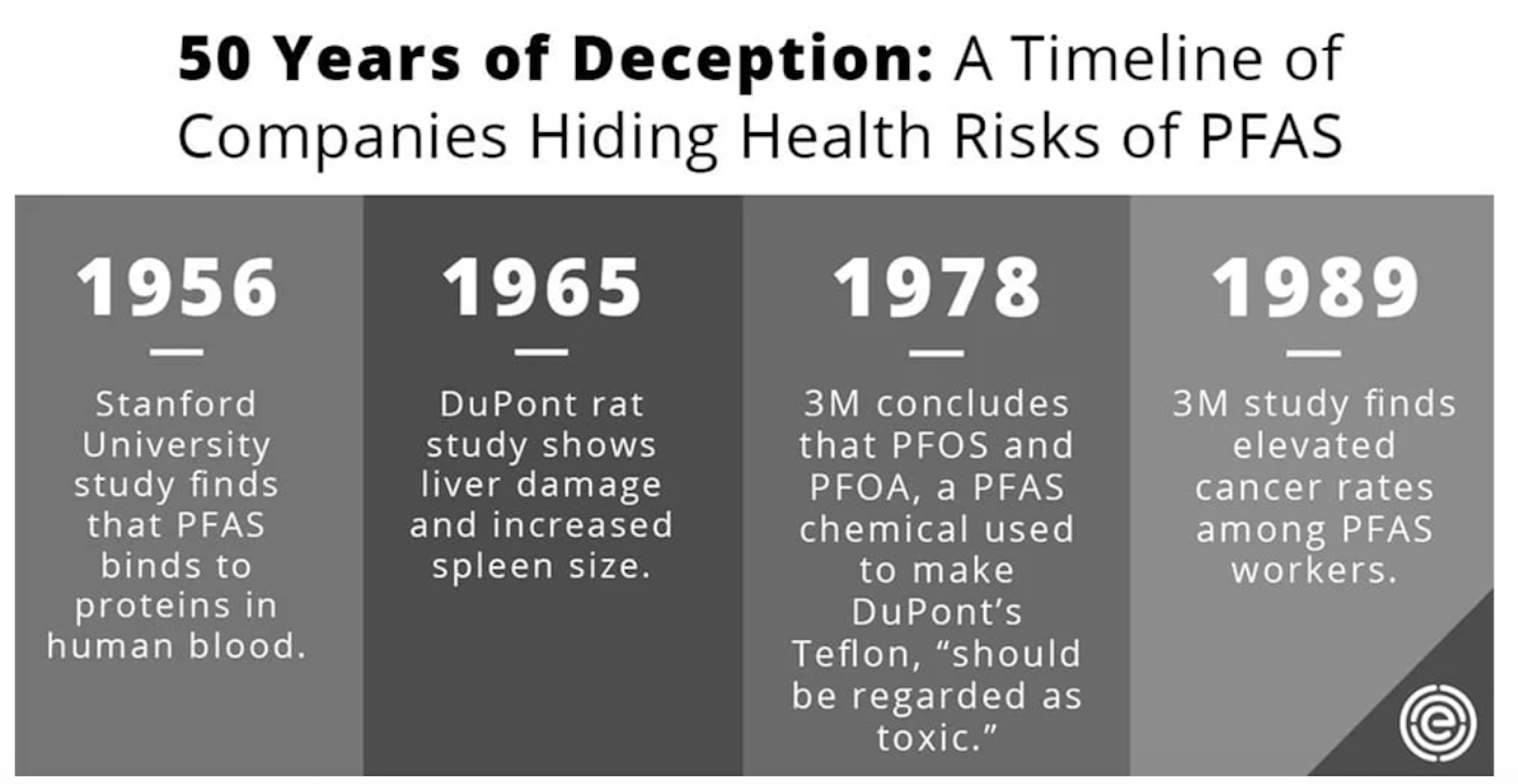
Source: https://www.ewg.org/pfaschemicals/what-are-forever-chemicals.html
See this link for an even more detailed timeline of PFAS and toxic chemicals.
What Are PFAS In?
PFAS functions in many capacities, including surfactants, friction reducers, and water, dirt, and oil repellents. (50:01)
As such, they are used in a wide variety of consumer products to confer nonstick (waterproof, greaseproof, and stainproof) and low-friction properties.
Examples of products that contain or coated with PFAS include:
- Some grease-resistant paper, fast food containers/wrappers, microwave popcorn bags, pizza boxes, and candy wrappers
- Nonstick cookware
- Stain-resistant coatings used on carpets, upholstery, and other fabrics
- Water-resistant clothing
- Umbrellas, tents, any fabric that repels water (pet bed covers, some mattresses, shoes, etc.)
- Cleaning products
- Personal care products (shampoo, dental floss) and cosmetics (nail polish, eye makeup)
- Paints, varnishes, and sealants
- Electronics
- Some industrial glass and plastics
PFAS are also used directly or as technical aids (dispersants and emulsifiers) in many industrial applications like metal coatings, lubricants for machinery, membranes, and firefighting foams.
PFAS are used in the synthesis of or as adjuvants in pesticides, in medical procedures and products, and in many other applications.
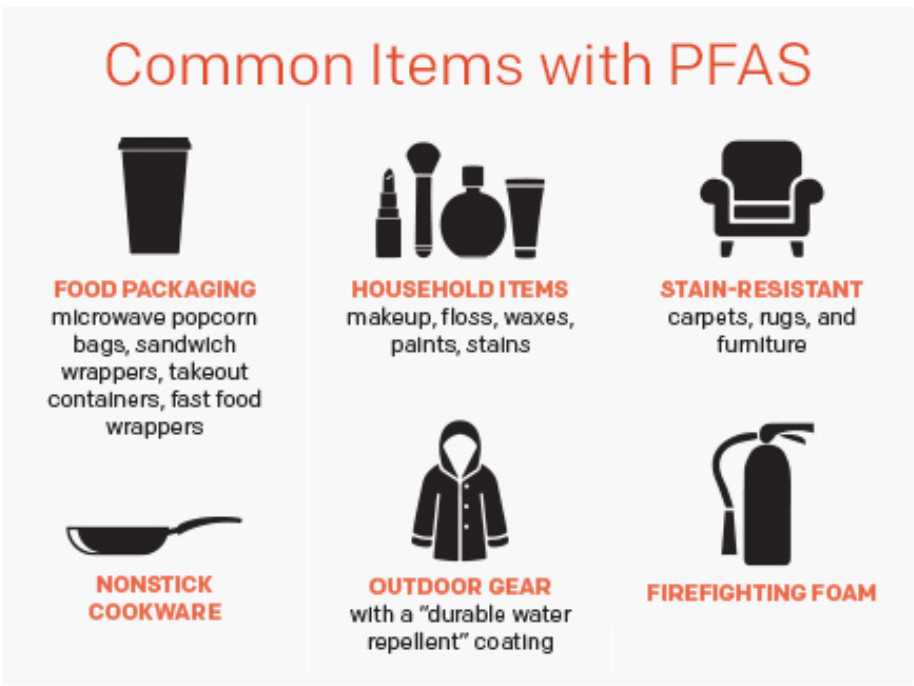
- This menstrual underwear is tested for PFAS-free
- I use this makeup almost exclusively because it is tested for safety
- PFAS-free dental floss here
- Look for low-VOC or used furniture without stain guard (Pottery Barn family complies)
PFAS in Cosmetics
The FDA has a voluntary registration program (VCRP) which shows an overall decrease in use (about half from 2019 to 2020).
But their site states- “because registration and product listing are voluntary, this data cannot draw definitive conclusions about the types and amounts of PFAS present in registered cosmetics or to determine which cosmetics may contain PFAS but have not been registered in the VCRP.”
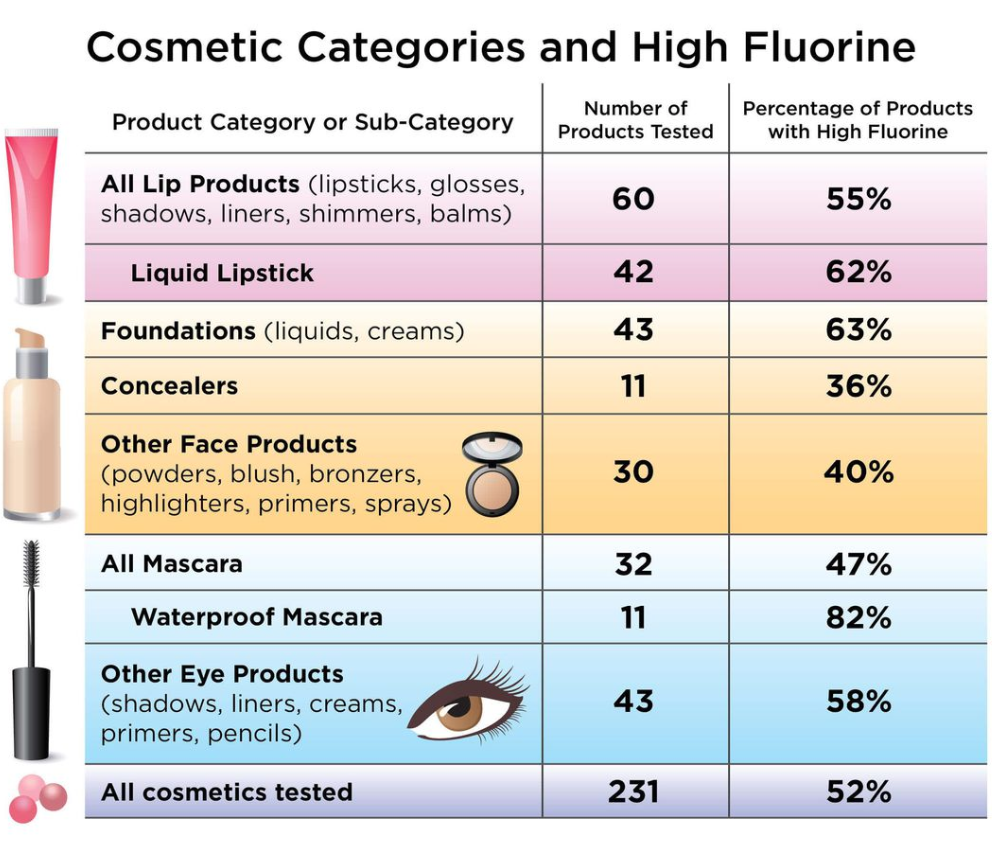
Source: https://www.fda.gov/cosmetics/cosmetic-ingredients/and-polyfluoroalkyl-substances-pfas-cosmetics
The Environment and Water Supply
Because of their widespread use, release, and disposal over the decades, PFASs show up virtually everywhere: soil, surface water, the atmosphere, the deep ocean—and even the human body.
The U.S. Centers for Disease Control and Prevention’s Web site says that the agency has found PFASs in the blood of nearly everyone it has tested for them, “indicating widespread exposure to these PFAS in the U.S. population.”
Scientists estimated that more than 200 million people—most Americans—have tap water contaminated with a mixture of PFOA and PFOS. These are at concentrations of one part per trillion (ppt) or higher.
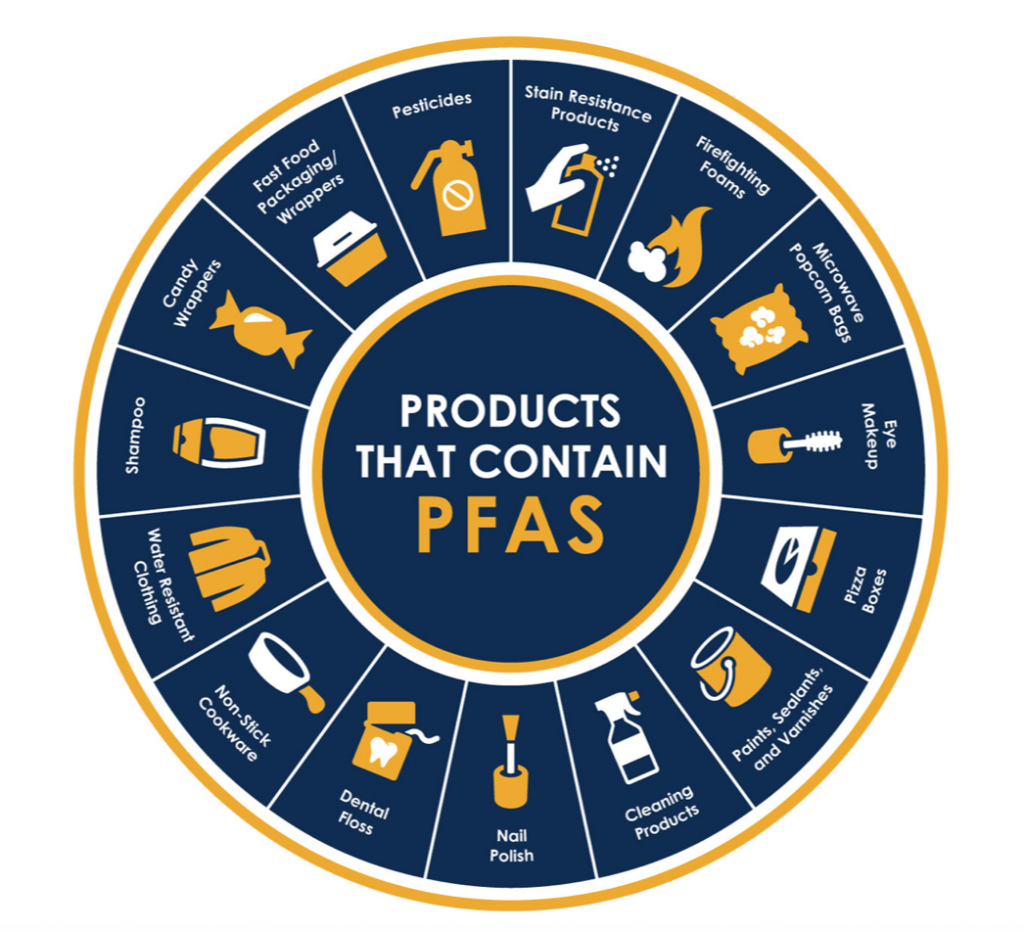
Problems with PFOA-Free (PFOS-free, PTFE-free)
The most well-studied of these substances, PFOA, and PFOS, have been linked to various health problems. (59:45)
Bad press and class-action lawsuits have put pressure on companies to discontinue the use of PFOA and PFOS, but not PFAS as a chemical class.
The regulatory bodies have not kept up with the chemical industry either!
When some major manufacturers phased out long-chain PFAS, most industries turned to structurally similar replacements. These include hundreds of homologues with fewer fluorinated carbons (short-chain PFAS) or other less well-known PFAS (e.g., per- and polyfluoroalkylether-based substances).
Producers marked these replacement PFAS as safer alternatives because of their presumed lower toxicity and lower level of bioaccumulation in human blood.
However, several lines of evidence suggest that short-chain PFAS are not safer alternatives.
Research demonstrated that short-chain PFAS can be equally environmentally persistent and are even more mobile in the environment and more difficult to remove from drinking water than long-chain PFAS.
Bioaccumulation of some short-chain PFAS occurs in humans and animals. For example, fish research suggests they can do more than the long-chain compounds they aim to replace.
Short-chain PFAS also can be more effectively taken up by plants. However, a growing body of evidence suggests they are associated with similar adverse toxicological effects as long-chain PFAS.
The ongoing accumulation of persistent chemicals known or potentially hazardous increases human and environmental health risks over an indefinite period.
Look for PFAS-free specifically. It’s not enough to be PFOA, PFOS, and PTFE-free.
What Can We Do About It?
The problem with these chemicals is that there unavoidable. However, we can take steps to protect ourselves. (1:05:01)
Make sure the makeup brands you’re using test for safety! PFAS and toxic chemicals are the kind of thing someone wouldn’t know about unless they checked and tested the product for them. If you shop Beautycounter, use code cleanforall20 for 20% off your purchase. Of course, you can always email Stacy for advice at stacy@realeverything.com!
Avoid plastics and coated papers for food storage whenever possible.
Also, avoid nonstick cookware or look for ceramic coatings that are PFAS-free, like Le Creuset or Greenpan or silicone liners.
Filter your water. Stacy and Sarah love AquaTru, which they talked about in Episode 406.
Also, be sure to think about other exposure areas, such as clothing, carpeting, etc.
Call Your Representatives! April 13, 2021, House representatives introduced the PFAS Action Act of 2021, a comprehensive 40-page piece of legislation that would require the Environmental Protection Agency (EPA) to take several significant PFAS regulatory actions.
Keep Food Containers Safe from PFAS Act (H.R. 2727) is soon to be reintroduced by Michigan Rep. Debbie Dingell.
Call your representatives to support the proposed environmental justice plan that specifically calls out forever chemicals, tackles PFAS pollution by designating PFAS as a hazardous substance, setting enforceable limits for PFAS in the Safe Drinking Water Act, prioritizing substitutes through procurement, and accelerating toxicity studies and research on PFAS.”
The new administration could carry out all of these goals unilaterally through executive action without Congress’s cooperation.
Dan Kildee (MI) and Brian Fitzpatrick are heading the bipartisan PFAS Task Force. They have a LONG list of people in the task force with goals.
- No PFAS in Cosmetics Act
- Personal Care Product Safety Act
- Natural Cosmetics Act (not updated since introduced in 2019)
Also, Stacy encourages you to text Better Beauty to 52886, which will cover these bases.
Support advocacy groups like Environmental Working Group, Toxic-Free Future | Science, Advocacy, Results, Safer Chemicals, Healthy Families, Earthjustice: Environmental Law: Because the Earth Needs a Good Lawyer | Earthjustice other local groups.
EPA says reverse osmosis (but not filters, like Brita, unfortunately) removes PFAS.
Lastly, don’t get suckered into PFAS detoxes! Currently, there is no established treatment for PFAS exposure. However, blood levels will decrease over time after a reduction in exposure to PFAS.
Final Thoughts
Though it’s not possible to completely rid ourselves of these forever chemicals in our lifetime, there are things we can do to make change and limit our exposure. (1:16:15)
Awareness is the most important step! And be sure to check out this link for more on Beautycounter advocacy for safer skincare.
To hear how Stacy and Sarah really feel about this topic, hop over to Patreon for bonus content. Your subscription goes to support this show and get you front-row access to Stacy and Sarah.
Thank you so much for joining us and we will see you next week!
